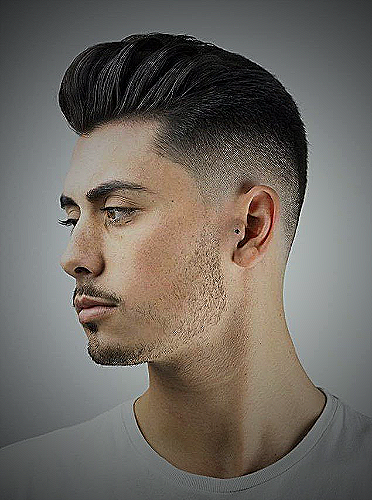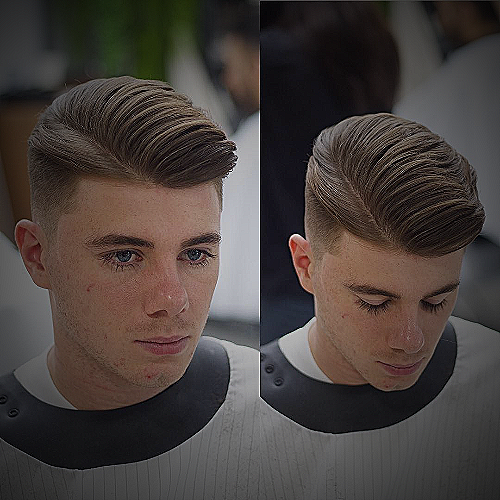The quiff and pompadour are two popular men‘s hairstyles that have been around for decades. They are both classic, stylish, and give men an edgy and suave look.
While they may look similar at first glance, there are key differences between these two hairstyles that set them apart. In this article, we will delve into the subtle nuances of the quiff and pompadour hairstyles, highlighting the key differences between these two styles.
Explanation of Quiff and Pompadour Hairstyles
The quiff is a short and spiky haircut that is brushed upward and forward to create an airy and light volume. The hair is cut shorter on the sides and back and left longer on the top.
The longer hair on top is then styled by using a comb or a hairbrush to create the signature quiff shape. The quiff is a versatile hairstyle that can be worn with or without a fade on the sides.
On the other hand, the pompadour is a more traditional and sophisticated haircut that has been around since the 18th century.
Check out this Youtube video and discover the differences between a quiff and a pompadour, and decide which one you should rock!
Don’t miss this amazing video “Modern Quiff vs. Modern Pompadour 2017” to learn how to style your hair like a pro!
History of the Quiff and Pompadour
The quiff and pompadour are two classic hairstyles that are often confused with each other. While both involve brushing up the front of the hair to add volume, there are distinct differences between the two styles.
Origins and Evolution of the Quiff
The quiff hairstyle first gained popularity in the 1950s among rockabilly musicians and has since become a timeless look for men. The style involves brushing the hair up and back from the forehead, creating a voluminous wave that can be styled in various ways.
The quiff was made famous by celebrities like James Dean, who popularized the look in the movie “Rebel Without a Cause.”
Over time, the quiff evolved into different variations, including the messy quiff, textured quiff, and disconnected quiff. While the classic quiff has a more defined shape, these modern variations have a more relaxed and casual look.
The quiff has become a versatile hairstyle that can be adapted to fit any face shape, hair type, or age group.
Origins and Evolution of the Pompadour
The pompadour, on the other hand, has a more formal and sophisticated look. The hairstyle originated in the 18th century during the reign of King Louis XV of France and was named after his mistress, Madame de Pompadour.
The style was characterized by its voluminous top and shorter sides, which were often slicked back to create a sleek and sophisticated look.
The pompadour regained popularity during the 1950s, when Elvis Presley made the hairstyle famous. Like the quiff, the pompadour has evolved over time to include different variations, including the messy pompadour and the modern undercut pompadour.
However, the classic pompadour still remains a timeless and elegant look for men.

Overall, while the quiff and pompadour share similarities, they have distinct differences that set them apart. The quiff is brushed upwards and forwards to create a casual and airy look, while the pompadour is brushed backwards to create a more formal and sleek appearance.
Both styles have a rich history and have remained popular throughout the years, proving their timelessness and versatility.
Quiff and Pompadour in Pop Culture
The Quiff and Pompadour hairstyles have been around for decades and have been popularized by many famous individuals.
Icons such as James Dean, John Travolta in Grease, and Elvis Presley have made the Pompadour famous in the 1950s. The Quiff, on the other hand, took off in the 1960s with the British invasion, popularized by The Beatles, making it a symbol of counter-culture.
In the 21st century, the Quiff and Pompadour remain popular with musicians, actors, and fashion-forward individuals. Artists such as Bruno Mars, Justin Timberlake, and David Beckham have showcased their variations of both styles, making them a staple in today’s pop culture.
Famous People Who Have Worn the Quiff and Pompadour
Many celebrities have become synonymous with Quiff and Pompadour hairstyles. Elvis Presley, who defined the ‘King of Rock and Roll’ image with his unique twist on the Pompadour.
James Dean’s classic, dishevelled version of the Pompadour became an iconic look in the 1950s. Meanwhile, Johnny Cash’s slick, refined hair version added an air of sophistication to the classic style.
The Quiff also has its share of celebrities who’ve styled the look to perfection, including James Stewart in Alfred Hitchcock’s Rear Window film in 1954. The Beatles’ mop-top hairstyles in the 60s, which became a pop-culture phenomenon with their catchy tunes, catchy outfits, and celebrity status, had many people copying their hairstyle.
Contemporary Trends in Quiff and Pompadour Hairstyles
The Quiff and the Pompadour have evolved over time, blending old-school style with modern twists. Quiffs today have looser textures and feathered edges, making them more laidback than the classic look.
Meanwhile, Pompadours continue to maintain their refined look, but can feature a more natural, effortless look.
Another trend that has emerged is the shaved side pompadour, famous among celebrities such as Justin Timberlake and Brad Pitt, adding a modern touch to the classic style. The contemporary Quiff and Pompadour stay true to their roots, continuing to be popular and fashionable among men worldwide.
Advantages of the Quiff vs Pompadour
The quiff hairstyle has gained immense popularity in recent years, thanks to its versatility and ease of maintenance. Here are some advantages of choosing a quiff over pompadour:
Quiff’s Versatility in Styling: Unlike the pompadour, the quiff can be styled in a variety of ways to suit different occasions and hair types. It can be worn short or long, with or without fades, textured or slicked back.
From a casual day out to a formal event, the quiff can be adapted to create the perfect look.
Quiff’s Low-Maintenance Requirement: The quiff requires low maintenance and can be styled easily with just a few products.
A good quality pomade or wax can provide hold and volume, and the style can be touched up throughout the day as needed. In contrast, the pompadour needs more precision and often requires regular maintenance to keep the shape intact.
Quiff’s Lighter and Airier Look: The main difference between the quiff and the pompadour is that the quiff creates a lighter and airier look, while the pompadour is denser and sleeker. The quiff places emphasis on the front of the hair, giving it more volume and texture, whereas the pompadour is brushed back to create a smooth and polished appearance.
The quiff is perfect for those looking for a relaxed and effortless style.
Advantages of the Pompadour vs Quiff
The pompadour, with its formal and sleek appearance, is a great choice for those looking for a more polished look. Unlike the quiff, which can appear youthful and playful, the pompadour can be styled to appear more refined and mature.
Its sleek appearance can help draw attention to the face and provide a more professional look.
Another advantage of the pompadour is its hair density and volume. While both the quiff and pompadour involve volumizing the front of the hair, the pompadour is brushed backward to make the hair denser and sleeker.
This can be particularly beneficial for those with fine or thin hair as it can help create the illusion of fuller, thicker hair.
Finally, the pompadour offers longevity in styling. Unlike the quiff, which has a more playful and casual appearance, the pompadour can be styled to suit any occasion.
Its polished look can work well at formal events or in the workplace, while its versatility ensures it can still be worn for more casual outings.

Drawbacks of the Quiff vs Pompadour
Quiff’s Limited Formal Usage
While the quiff is a versatile hairstyle suitable for both casual and formal settings, it is limited in its application for formal occasions. The airy and light volume it creates may not fit the dress code of some events, and depending on the length and thickness of the hair, a quiff can be difficult to maintain and style consistently for a polished, formal look.
In such cases, the pompadour, with its denser and sleeker appearance, may be a more suitable option.
Quiff’s Unsuitability for Certain Hair Types
The quiff requires a certain length and texture of hair to achieve the desired volume and height. Those with fine, thin hair may find that their quiff falls flat and lacks the intended volume, while those with curly or wavy hair may struggle to achieve a smooth and structured quiff.
In contrast, the pompadour’s brushed-back style can work well with a variety of hair types and textures.
Quiff’s Risk of Looking Messy
While the quiff’s voluminous and tousled appearance is intended to look effortlessly stylish, it can also risk appearing messy or unkempt. Without proper styling and maintenance, a quiff can quickly lose its shape and become unruly, detracting from the overall look.
In comparison, the pompadour’s sleeker and more structured appearance is easier to maintain and less prone to appearing messy.
Drawbacks of the Pompadour vs Quiff
While both the pompadour and quiff hairstyles are trendy and stylish, there are certain drawbacks to consider before choosing to rock either of these looks. Here are some drawbacks of the pompadour compared to the quiff:
Pompadour’s High Upkeep and Styling Time Requirement: The pompadour requires a lot of upkeep and styling time, especially if you have thick or unruly hair.
This is because it involves brushing the hair backwards to create a dense and sleek appearance. You may have to use a lot of product, such as hairspray or wax, to keep the hair in place.
This can be time-consuming, especially if you have a busy schedule or prefer low-maintenance hairstyles.
Pompadour’s Preference for Specific Face Shapes and Hair Textures: Another drawback of the pompadour is that it may not flatter all face shapes and hair textures. This is because the height and volume of the hairstyle can make the face appear wider and rounder.
If you have a round or oval face shape, a pompadour may not be the best option for you. Similarly, if you have thin or fine hair, you may find it challenging to create the needed volume and density for a pompadour.
Pompadour’s Tendency to Look Overstyled or Gaudy: Finally, the pompadour can sometimes look overstyled or gaudy, especially if not executed carefully or if the height is too extreme.
This is because the hairstyle requires a lot of volume, which can exaggerate the size of the head and make the face appear disproportionate. If you prefer a more natural or effortless look, the pompadour may not be the right choice for you.
Overall, while the pompadour remains a classic and iconic style, it may not be the most practical or versatile option. If you prefer a more relaxed and airy hairstyle, the quiff may be a better fit for you.
How to Choose Between the Two
Deciding between a quiff and a pompadour hairstyle can be daunting. While both involve brushing up the front of the hair to add volume, there are some key differences to consider that can help you choose which one is right for you.
Considerations for Choosing Either
The quiff is airier and lighter, brushed forward to create volume. Meanwhile, the pompadour is brushed backward to create denser, sleeker hair.
The high-shine classic pompadour requires a lot of hair and more styling products than the quiff to keep it looking its best. Additionally, facial hair pairs well with the pompadour, while a clean-shaven look can complement the quiff.
Best Situations to Wear a Quiff or Pompadour Hairstyle
The modern quiff with a sharper fade is perfect for those looking for a sharp, modern look. Meanwhile a less pronounced fade can add a more relaxed feel to the hairstyle.
The quiff is versatile enough to suit different occasions, from casual to formal settings. On the other hand, the pompadour is best reserved for more formal events like weddings and special occasions.

